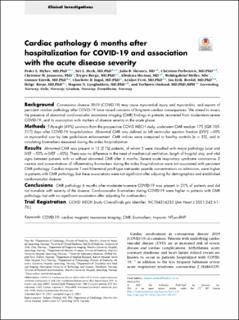| dc.contributor.author | Myhre, Peder Langeland | |
| dc.contributor.author | Heck, Siri Lagethon | |
| dc.contributor.author | Skranes, Julia Brox | |
| dc.contributor.author | Prebensen, Christian Haugland | |
| dc.contributor.author | Jonassen, Christine M | |
| dc.contributor.author | Berge, Trygve | |
| dc.contributor.author | Mecinaj, Albulena | |
| dc.contributor.author | Einvik, Gunnar | |
| dc.contributor.author | Melles, Woldegabriel A | |
| dc.contributor.author | Ingul, Charlotte Bjørk | |
| dc.contributor.author | Tveit, Arnljot | |
| dc.contributor.author | Berdal, Jan-Erik | |
| dc.contributor.author | Røsjø, Helge Rørvik | |
| dc.contributor.author | Lyngbakken, Magnus Nakrem | |
| dc.contributor.author | Omland, Torbjørn | |
| dc.date.accessioned | 2022-02-10T15:09:20Z | |
| dc.date.available | 2022-02-10T15:09:20Z | |
| dc.date.created | 2022-01-02T08:48:18Z | |
| dc.date.issued | 2021 | |
| dc.identifier.citation | American Heart Journal. 2021, 242 61-70. | en_US |
| dc.identifier.issn | 0002-8703 | |
| dc.identifier.uri | https://hdl.handle.net/11250/2978312 | |
| dc.description.abstract | Background
Coronavirus disease 2019 (COVID-19) may cause myocardial injury and myocarditis, and reports of persistent cardiac pathology after COVID-19 have raised concerns of long-term cardiac consequences. We aimed to assess the presence of abnormal cardiovascular resonance imaging (CMR) findings in patients recovered from moderate-to-severe COVID-19, and its association with markers of disease severity in the acute phase.
Methods
Fifty-eight (49%) survivors from the prospective COVID MECH study, underwent CMR median 175 [IQR 105-217] days after COVID-19 hospitalization. Abnormal CMR was defined as left ventricular ejection fraction (LVEF) <50% or myocardial scar by late gadolinium enhancement. CMR indices were compared to healthy controls (n = 32), and to circulating biomarkers measured during the index hospitalization.
Results
Abnormal CMR was present in 12 (21%) patients, of whom 3 were classified with major pathology (scar and LVEF <50% or LVEF <40%). There was no difference in the need of mechanical ventilation, length of hospital stay, and vital signs between patients with vs without abnormal CMR after 6 months. Severe acute respiratory syndrome coronavirus 2 viremia and concentrations of inflammatory biomarkers during the index hospitalization were not associated with persistent CMR pathology. Cardiac troponin T and N-terminal pro-B-type natriuretic peptide concentrations on admission, were higher in patients with CMR pathology, but these associations were not significant after adjusting for demographics and established cardiovascular disease.
Conclusions
CMR pathology 6 months after moderate-to-severe COVID-19 was present in 21% of patients and did not correlate with severity of the disease. Cardiovascular biomarkers during COVID-19 were higher in patients with CMR pathology, but with no significant association after adjusting for confounders.
Trial Registration
COVID MECH Study ClinicalTrials.gov Identifier: NCT04314232 | en_US |
| dc.language.iso | eng | en_US |
| dc.publisher | Elsevier | en_US |
| dc.rights | Navngivelse 4.0 Internasjonal | * |
| dc.rights.uri | http://creativecommons.org/licenses/by/4.0/deed.no | * |
| dc.title | Cardiac pathology 6 months after hospitalization for COVID-19 and association with the acute disease severity | en_US |
| dc.type | Peer reviewed | en_US |
| dc.type | Journal article | en_US |
| dc.description.version | publishedVersion | en_US |
| dc.source.pagenumber | 61-70 | en_US |
| dc.source.volume | 242 | en_US |
| dc.source.journal | American Heart Journal | en_US |
| dc.identifier.doi | 10.1016/j.ahj.2021.08.001 | |
| dc.identifier.cristin | 1973297 | |
| cristin.ispublished | true | |
| cristin.fulltext | original | |
| cristin.qualitycode | 1 | |

